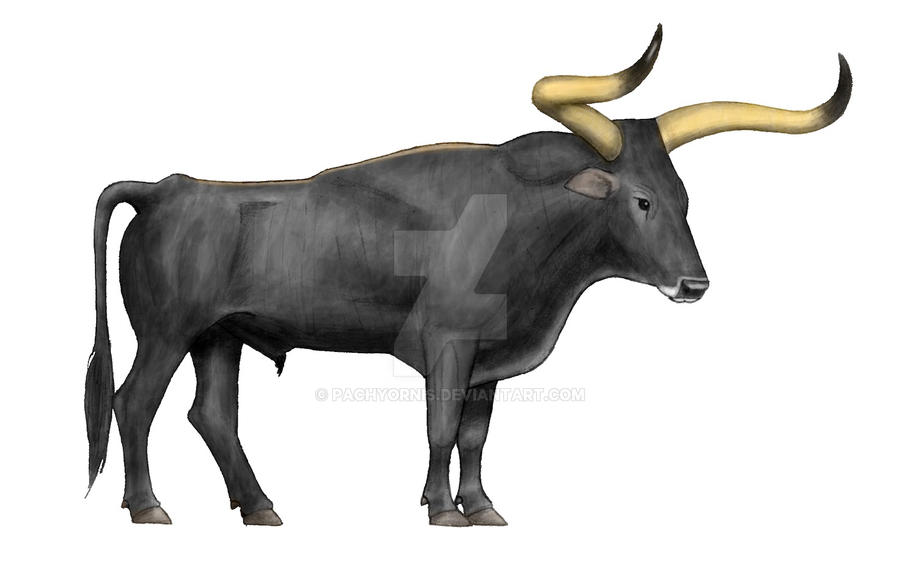Aurochs calves were born of a reddish chestnut brown colour, and grew their adult colour in their first year. The reddish brown base colour becomes superseded by black hairs that steadily increase in number. This darkening of the coat starts on the head and neck, the legs and ventral side of the trunk. I call this darkening of the coat the process of eumelanisation (eumelanin is the black pigment in mammals). When the eumelanisation is completed, the whole body is black except for a lightly coloured dorsal stripe and mouth. This was the colour of the bulls. Bulls with a colour saddle did very likely not exist in the European subspecies (go here). In cows, the eumelanisation is stopped earlier. Depending on the degree of eumelanisation, cows can display a wide range of colours which I illustrated in the drawing down below:
I am not so sure about the top left phenotype, but the other phenotypes are proven for aurochs cows based on cave paintings and historic records. It has to be noted that bull-coloured cows are reported to have been very rare.
In wildtype coloured cattle (cattle with a phenotype caused by the E+ allele on the Extension locus) we have the same mechanism. The difference is that in most breeds domestication has caused a chaos regarding the degree of eumelanisation: some breeds are bull-coloured in both sexes, such as Sayaguesa where the cows are bull-coloured in many cases, or the dichromatism is at least reduced by bulls having a colour saddle, such as in Alistana-Sanabresa, or both sexes have a very reduced eumelanisation, such as Cachena and Barrosa, for example. Only some breeds have retained the dichromatism we see in the aurochs, such as Maronesa (the bulls are always black, and most cows are less eumelanised than the bulls), or the old lineage of Corsican cattle, which is almost extinct due to crossbreeding with more productive breeds. In those two breeds, all the alleles involved in the production of the colour are very likely the original alleles of the aurochs otherwise we would see a different phenotype.
The genetic background of the sexual dichromatism found in Bos primigenius is not resolved yet. The genetic program of the eumelanisation process can be located anywhere on the genome. The degree of eumelanisation is said to be dependent on the testosterone level. Bull calves that get castrated before they grow their adult colour grow the colour of cows. This explanation, that eumelanin is only dependent on testosterone level, cannot be the whole story, however, as this would mean that a Sayaguesa cow (which usually is more or less fully eumelanised) has more testosterone than a Barrosa bull (which is barely eumelanised), which is very implausible. Consequently, it must be the alleles that regulate the degree of eumelanisation that mutated in these cattle, with some alleles needing a higher level of testosterone (resulting in less eumelanised sexes) and some alleles needing a lower level of testosterone (resulting in bull-coloured cows) to become active. This is a speculation, but the only plausible one to me.
How to breed for a well-marked sexual dichromatism as in the aurochs? Crossbreeding shows that trying to reduce the eumelanisation of bull-coloured cows by crossing in a less eumelanised breed does not increase the degree of sexual dichromatism. This has been shown in the Sayaguesa herds of Peter van Geneijgen, who incorporated individuals influenced by Alistana-Sanabresa, a less eumelanized breed. The results were less eumelanized cows (thus with “cow colour”), but also in some bulls having a colour saddle. Thus, the sexual dichromatism did not increase, even though some cows are now correctly coloured.
This tells us that working with two breeds which have a reduced sexual dichromatism cannot result in an increased sexual dichromatism. One would have to take a breed with the right alleles having the right sensitivity for testosterone, if my assumption above is correct. Thus, the right sexual dimorphism can only be achieved if there is a breed that already has it. Luckily, this is the case as there are at least two breeds in Europe with that trait (Maronesa and Corsican cattle).
There are “breeding-back” herds that have a satisfying degree of sexual dichromatism. For example, the Hellabrunn Heck herd has a excellent colour and dichromatism (go here). I evaluated the sexual dichromatism in the Lippeaue population using a photo archive (go here). The result was that more than 80% of the individuals have the right degree of eumelanisation for their sex. Of course some individuals that are correctly coloured might pass on individuals with no sexual dichromatism, f.e. bull-coloured bulls that pass on bull-coloured cows or cow-coloured cows that pass on bulls with a saddle. In order to increase the sexual dichromatism, it would have to be possible to discriminate between those individuals and those that pass on sexual dichromatism, which is hitherto impossible as the genetic background of this trait is not resolved.
Heck cattle have their sexual dichromatism from Corsican cattle, and Taurus cattle has it from Heck cattle (Chianina might contribute an at least moderately developed dichromatism as well, it could be masked beneath the dilution alleles producing the white colour).
Achieving a well-marked sexual dichromatism might become problematic for the Tauros Programme and perhaps also the Auerrind project. Many Tauros cows are rather dark and bulls often have a saddle, and most of the founding breeds have a more or less reduced sexual dimorphism (Maremmana, Highland, Sayaguesa, Podolica, Boskarin, Pajuna), they use Maronesa only on a small scale in the form of four cows and a few bulls in Dutch herds as far as I am informed. For the Auerrind project, all of the founding breeds have a reduced sexual dichromatism (Sayaguesa, Watussi, Maremmana, Hungarian Grey, Pajuna, perhaps Chianina). So far, not enough crossbred animals have been produced to judge the sexual dichromatism in the Auerrind herds.




